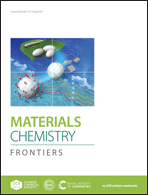“Net fishing” of synthesized micelle-scale single hollow polymer nanospheres from a solution
Abstract
The controlled preparation and collection of micelle-scale single hollow particles from colloidal solutions remains a significant challenge owing to their small size and low density, beyond the separation capabilities of centrifugation and filtration. Herein, an effective strategy for the preparation and separation of micelle-scale single hollow polymer spheres (SHPS) from a stable colloid system is presented, inspired by “net-fishing”, where 2D graphene oxide (GO) nanosheets were utilized as fishing nets to capture these SHPSs from colloidal solution via electrostatic attraction. As a consequence, SHPSs were enriched on the GO surface. In the control case, they automatically assembled into monolayer ordered hexagonal honeycomb-like nanoarrays on the entire surface of GO. Moreover, the key factors governing the formation of the ordered nanoarrays and the arrangement rules were studied via adjusting parameters such as the pH and the mass ratio of SHPSs/GO, and the formation mechanism of the ordered nanoarray was also demonstrated using a study model. This strategy provides a novel avenue for the capture of lightweight colloidal particles and, thus, the construction of multiply ordered assemblies.



 Please wait while we load your content...
Please wait while we load your content...